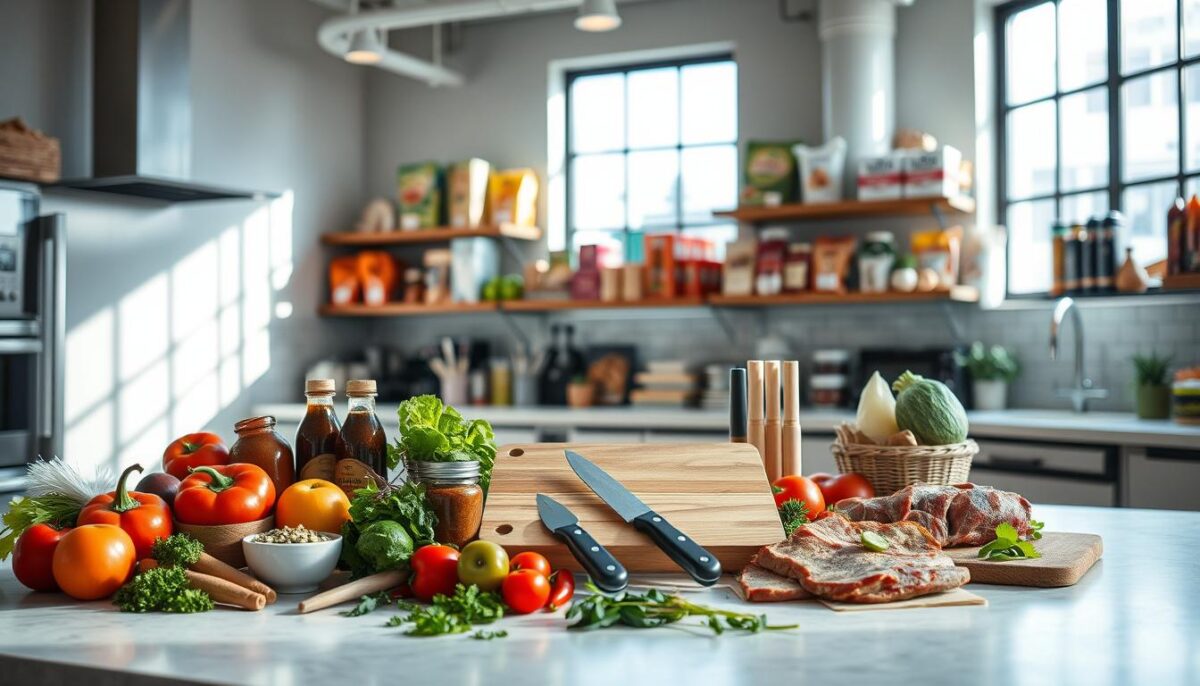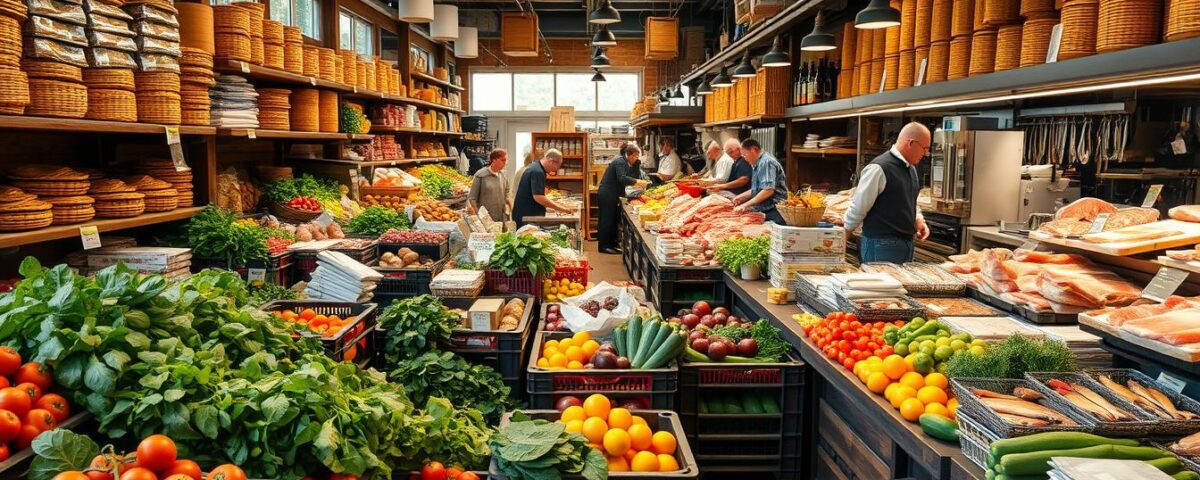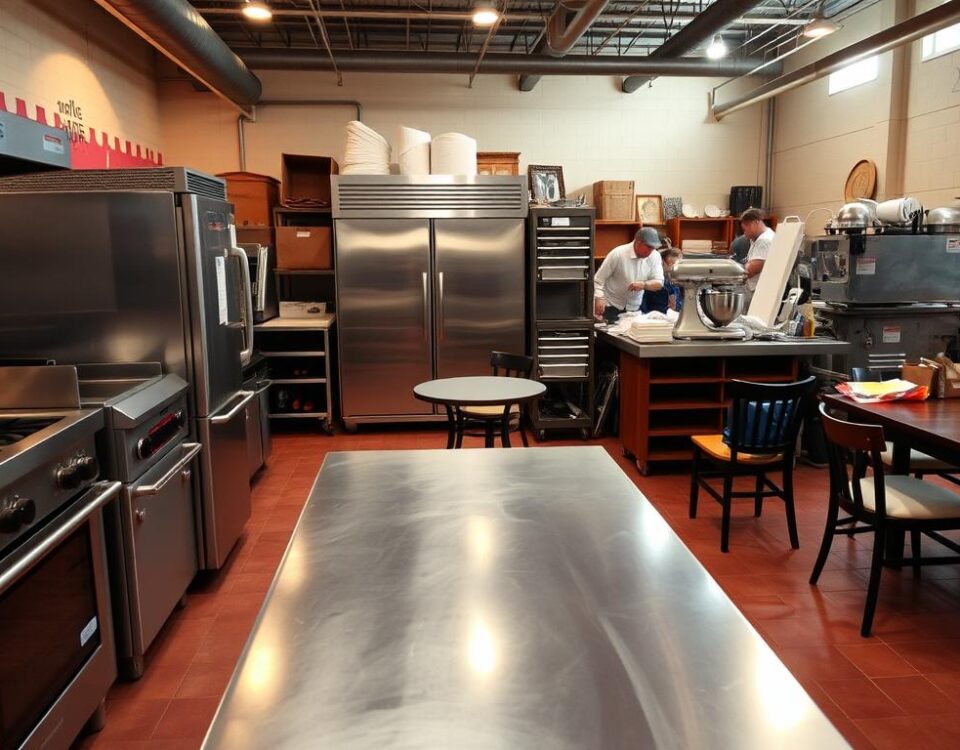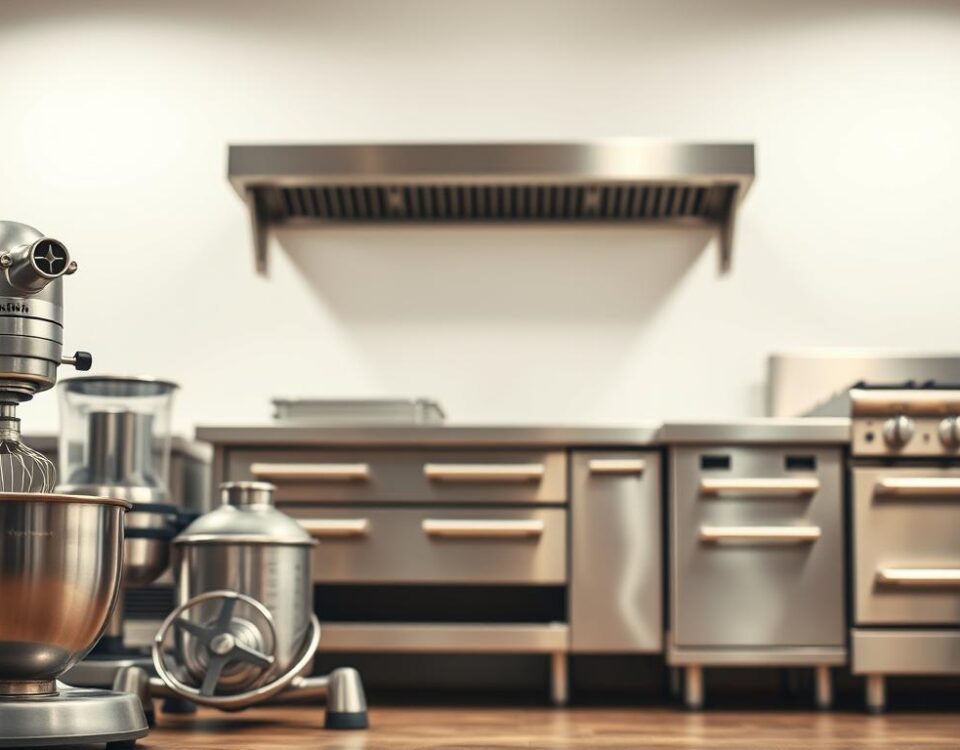
Why Picking the Wrong Distributor Can Harm Your 2025 Food Costs
August 15, 2025
How to Price Restaurant Menus Using New York Produce Costs
August 16, 2025As a restaurant owner, I’ve learned that managing food supplies is crucial to maintaining profitability. With years of experience in managing restaurant supply chains, I’ve discovered that strategic wholesale food purchasing can significantly impact your bottom line.
Did you know that the restaurant industry operates on razor-thin margins? Effective supply chain management can be the difference between thriving and merely surviving. By applying the right strategies, you can enjoy premium food products without breaking the bank.
By following my five golden rules, you’ll be able to optimize your restaurant’s food purchasing process, ensuring you get the best value for your money. Are you ready to transform your restaurant’s profitability?
Key Takeaways
- Understand the importance of strategic wholesale food purchasing for your restaurant’s profitability.
- Learn practical strategies for effective inventory management and supplier relationships.
- Discover how to optimize your online ordering process for better results.
- Gain insights into selecting the right products for your restaurant.
- Future-proof your supply chain with expert advice.
Understanding the Wholesale Food Landscape
Navigating the complex world of wholesale food suppliers is crucial for any restaurant’s success. The wholesale food landscape is constantly evolving, with new products, suppliers, and ordering technologies emerging regularly.
Types of Wholesale Food Suppliers
I’ve found that understanding the different types of suppliers available to your restaurant is vital. These include broadline distributors, specialty vendors, and local producers. Each supplier category offers distinct advantages – broadliners provide one-stop shopping convenience, specialty vendors offer unique products, and local producers can provide fresher foods with marketing appeal.

Essential Categories of Restaurant Consumables
Restaurant consumables typically fall into several essential categories: proteins, produce, dairy, dry goods, frozen items, beverages, and specialty ingredients. These foods are the foundation of any foodservice business, and it’s crucial to maintain an organized inventory.
Balancing Quality and Cost in Wholesale Purchasing
I always emphasize the importance of understanding the true cost of goods beyond just the price tag. Factors like yield, labor requirements, and storage needs all impact the actual value of wholesale foods. Finding the sweet spot between quality and cost is crucial – I’ll show you which items justify premium pricing and where you can save without compromising your menu’s integrity.
Rule #1: Strategic Inventory Management for Maximum Savings
By implementing a well-organized inventory system, restaurants can significantly reduce waste and optimize their purchasing. This involves understanding the different types of inventory and how to manage them effectively.
Organizing Your Food Inventory System
A well-organized inventory system is the foundation of smart purchasing. I’ve implemented inventory systems across dozens of restaurants and found that proper organization by count, container type, and weight (oz. or lb.) creates the foundation for smart purchasing. For instance, categorizing items by usage rate, shelf life, and storage requirements helps optimize both ordering frequency and quantities.
Balancing Fresh, Frozen, and Dry Goods
It’s essential to strike a balance between fresh, frozen, and dry goods in your inventory. This requires understanding the trade-offs between quality, convenience, and shelf-life for each product category. For example, fresh produce may have a shorter shelf life, while frozen goods can be stored for longer periods. By balancing these categories, you can ensure that you’re always stocked with the ingredients you need.
| Product Category | Shelf Life | Storage Requirements |
|---|---|---|
| Fresh Produce | 3-5 days | Refrigerated |
| Frozen Goods | Several months | Freezer |
| Dry Goods | Several months | Dry storage |
Preventing Waste Through Smart Ordering
Smart ordering isn’t just about what you buy, but also when you buy it. By timing your purchases to take advantage of seasonal pricing fluctuations and supplier promotions, you can save significantly. Additionally, preventing waste through proper inventory rotation, storage techniques, and pack size selection can save your restaurant thousands of dollars annually. Implementing a digital inventory system that tracks product usage patterns can help predict needs based on historical data rather than guesswork.
By implementing these strategies, you can optimize your inventory management and maximize savings. For example, using a container that is the right size for your needs can help reduce waste and save on storage costs.
Rule #2: Mastering the Art of Buying Wholesale Food for Restaurants

The art of purchasing wholesale food for restaurants involves more than just finding the lowest price. It requires a deep understanding of the food industry, a keen eye for quality, and the ability to negotiate effectively with suppliers.
Building Relationships with Reputable Suppliers
I’ve learned that building strong relationships with reputable suppliers is about more than just getting the best price – it’s about securing consistent quality, reliable delivery, and preferential treatment during shortages. When I work with trusted suppliers, I can ensure that my restaurant receives the freshest food and beverage products, including premium cheese and dairy products.
Negotiating Better Terms and Pricing
When negotiating with wholesale food suppliers, I focus on the total package: price breaks, payment terms, delivery schedules, and value-added services that can benefit my restaurant. For instance, I’ve developed specific strategies for negotiating different food categories – for example, approaches for cheese and dairy products differ significantly from those for dry goods or beverage supplies.
When to Buy in Bulk vs. Small Quantities
Understanding when to buy in bulk versus smaller quantities depends on several factors: storage capacity, cash flow, product shelf life, and usage rate. Buying any product in bulk is one of the easiest ways to save money, but it’s crucial to calculate the true savings, accounting for storage costs, spoilage risk, and capital tied up in inventory.
By mastering the art of buying wholesale food for my restaurant, I can enjoy premium food and professional beverage service without breaking the bank. This involves maintaining relationships with multiple suppliers, allowing me to comparison shop while still maintaining the leverage that comes with loyalty.
Rule #3: Leveraging Online Ordering to Save Time and Money
Embracing online ordering can revolutionize the way restaurants manage their wholesale food supplies. With just a few clicks on our website today, you can place your order and have it shipped right to your door, usually within 5-7 business days.
Benefits of Online Wholesale Food Ordering
I’ve transitioned numerous restaurants to online ordering systems and witnessed firsthand how this approach saves both time and money while reducing errors. Online wholesale platforms allow for precise ordering by count and weight (oz.), making it easier to track and compare prices across different suppliers’ websites.
Evaluating Shipping Costs and Delivery Timeframes
When evaluating online suppliers, I look beyond the product price to assess shipping costs, delivery timeframes, minimum order requirements, and return policies. This ensures that you’re getting the best deal for your business.
Creating an Efficient Online Ordering Schedule
I’ve developed a staggered ordering schedule that optimizes delivery timing to ensure fresh products arrive just when needed while maintaining adequate safety stock. The data tracking capabilities of online ordering systems provide valuable business intelligence that can help identify cost-saving opportunities and usage patterns over time.
By ordering on our website today, you can start experiencing the benefits of online wholesale food ordering for your business. With the ability to track your orders by count and weight (oz.), you’ll have complete control over your inventory.
Rule #4: Selecting the Right Mix of Premium and Value Products
To maximize profitability, it’s essential to strike a balance between premium ingredients and cost-effective alternatives. This strategic approach to product selection can significantly impact your restaurant’s bottom line.

Identifying Where Quality Matters Most
For menu staples like french fries that appear on nearly every plate, I recommend testing multiple brands and varieties by count and oz. to find the optimal balance of quality and value. My “signature item” principle identifies which 20% of your ingredients create 80% of your flavor impact – these are where premium quality justifies higher costs.
Cost-Effective Alternatives for Non-Critical Items
For non-critical background ingredients, I recommend developing a systematic approach to evaluating private label and economy options against name brands. Understanding product specifications and grading systems for items like fries and other frozen products helps ensure you’re making value-based comparisons rather than just price-based ones.
Smart Approaches to Specialty and Seasonal Items
Seasonal planning allows you to take advantage of harvest cycles for better pricing and quality, particularly for produce and specialty items measured by mix lb.. By doing so, you can capitalize on the freshness and mix of ingredients during their peak season.
| Product | Premium Option | Value Alternative |
|---|---|---|
| French Fries | High-end brand | Private label |
| Onion Rings | Name brand | Economy option |
| Green Beans | Organic | Conventional |
By implementing these strategies, you can effectively manage your wholesale food costs while maintaining the quality that your customers expect.
Rule #5: Future-Proofing Your Restaurant’s Supply Chain
In today’s fast-paced culinary landscape, having a resilient supply chain can make all the difference. As a restaurant owner, I’ve learned that being prepared for potential disruptions is crucial to maintaining customer satisfaction and loyalty.
Developing Contingency Plans for Supply Disruptions
To minimize the impact of supply chain disruptions, I recommend developing contingency plans that identify critical items by count, oz., and lb.. This involves maintaining relationships with multiple suppliers for essential foods and developing specifications that allow for acceptable substitutions when necessary.
Staying Informed About Market Trends and Price Fluctuations
Staying ahead of the curve requires staying informed about agricultural markets, weather patterns, and global trade issues. I’ve developed a system for monitoring price trends across key product categories, which helps identify when to lock in pricing or adjust menu offerings.
Some non-perishable food items, such as bulk canned products like soups, canned meat, canned chili, and flavor enhancers, are perfect for storing at home or for commercial use. Strategic inventory management of these shelf-stable items provides a buffer against short-term supply disruptions while minimizing tied-up capital.
| Product Category | Count | Weight (lb.) | Storage Requirements |
|---|---|---|---|
| Canned Goods | 100 | 50 | Cool, dry place |
| Spices and Seasonings | 50 | 10 | Airtight containers |
| Condiments | 20 | 5 | Refrigerated storage |
Conclusion
Now that we’ve covered the five golden rules, it’s time to put them into action for a more profitable restaurant business. By implementing strategic inventory management for your entire product range – from french fries to coffee, cheese to spices – you’ll create a foundation for smart purchasing decisions. Building strong supplier relationships while leveraging online ordering platforms gives you the best combination of personal service and technological efficiency.
Remember, wholesale purchasing isn’t just about finding the lowest price per lb., oz., or count – it’s about maximizing overall value while maintaining quality standards. I encourage you to start implementing these strategies today, beginning with an audit of your current inventory and supplier relationships. Place your order online at Warehouse115 today, and get more value for your dollar. Only at Warehouse115.com!
FAQ
What are the benefits of purchasing pure cane sugar and granulated sugar in bulk?
I can save money on my restaurant’s sugar supplies by purchasing in bulk, and ensure a consistent supply of high-quality sugar for my baked goods and beverages.
How do I determine the best coffee and beverage suppliers for my restaurant?
I evaluate potential suppliers based on factors like product quality, pricing, and customer service, and consider factors like shipping costs and delivery timeframes to ensure timely restocking.
What are some strategies for reducing waste when ordering frozen and dry goods in bulk?
I implement a first-in, first-out inventory system, carefully plan my orders to match my restaurant’s needs, and consider the shelf life of products like ice cream and frozen fries.
Can I negotiate better prices with suppliers by purchasing larger quantities of spices and condiments?
Yes, I can often negotiate better prices with suppliers by committing to larger orders, and building a strong relationship with my suppliers to secure the best possible terms.
How do I balance the need for quality with the need to control costs when purchasing wholesale products?
I prioritize quality for critical items like cheese and meat, while exploring cost-effective alternatives for non-critical items, and consider factors like product freshness and packaging.
What are some best practices for storing and handling bulk ingredients like sugar, flour, and oil?
I ensure that my storage facilities are clean, dry, and well-ventilated, and follow proper handling and labeling procedures to maintain product quality and safety.
How can I stay informed about market trends and price fluctuations in the wholesale market?
I stay up-to-date with industry news and trends, and regularly review my supplier contracts to ensure I’m getting the best possible prices for products like coffee, beverages, and baking supplies.



